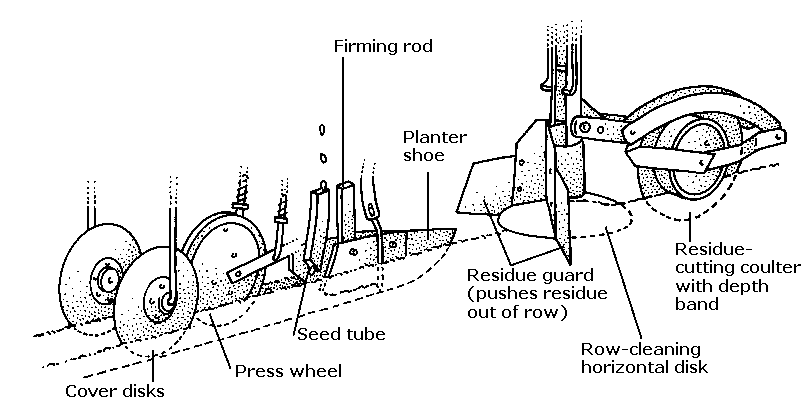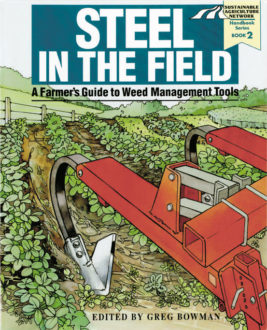Agronomic Row Crops
Ridge-till Planter
Ridge tillage uses permanent elevated rows 30" or more apart that keep traffic off the row area.

Cultivation is central to ridge tillage. Suitable cultivators can handle residue and work 4" to 6" deep. Disk hillers need to be height-adjustable to run higher than sweeps for early passes. At first cultivation (corn more than 3" tall, soybeans more than 2"), disk hillers skim weeds from sides of the ridge (moving soil into row middles) while wide sweeps run lower to undercut weeds in row middles.
Second cultivation controls later weeds just before crops form a shade canopy and also creates ridges for the next season. A narrower sweep prevents damage to developing crop roots. The disk hillers are set to move soil back into the row. The best (flat or gently rounded) ridges are formed by ridging wings, which are mounted on cultivator shanks. The wings push soil - flowing back from sweeps and disk hillers - into the row area, rebuilding the ridge. The soil moved into the row smothers weeds, preserves moisture in the root area and anchors stalks against lodging. Minimize soil hilling in soybeans that could interfere with harvest of low-hanging pods.
Ridge-tilled fields are left undisturbed - except for optional stalk chopping - until the next planting season. Residue tends to accumulate in the middles, but also protects the ridges over winter. Elevated stalks and ridge height helps trap snow - a benefit in dryland areas. In the spring, ridge tops dry and warm more quickly than unridged ground. Ridge tillage is especially suited to flat fields of slow-drying or heavy soils, in contoured rows on slopes up to 6 percent, or for furrow-irrigated fields.
Ridge-till planters are unique in their ability to be configured to significantly suppress weeds. The planters do two things: 1. Skim a thin layer of weed seed-laden soil and residue from the old seedbed's row area; 2. Plant crop seeds by placing them into firmed, moist soil then covering them with loose, drier soil. Preventing weed seed-soil contact delays weed growth in the row area, giving the crop an advantage.
Design Features: Tooling may include a residue-cutting coulter with depth-gauge wheels or a depth-banded coulter (to cut residue and provide uniform cleaning depth); a wide sweep, horizontal disk or double vertical disks (to move soil from the row area and create a weed-free seedbed); trash guards or residue wings (to push disturbed soil and residue into row middles); a seed press wheel; and small cover disks and/or a harrow trailing to cover the seed row.
List price: Six rows on 30" centers
Conversion kits: $200 to $360 per row
Complete planters: $14,080
Sources: Whole goods: 43;
Conversions: 20, 35, 43
See: Thompson
